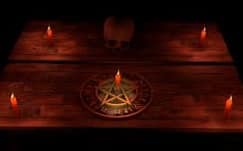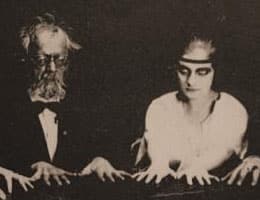 Divination that is carried out by invoking the deceased is called necromancy . According to the Royal Spanish Academy ( RAE ), the term can also be mentioned as necromancy , necromancy or necromancy .
Divination that is carried out by invoking the deceased is called necromancy . According to the Royal Spanish Academy ( RAE ), the term can also be mentioned as necromancy , necromancy or necromancy .
Necromancy is part of the so-called black magic . To carry out his actions, he uses corpses or viscera of deceased people or animals . He also usually asks the spirits .
The origins of necromancy are remote: many ancient cultures used its practices to try to predict the future or access certain knowledge. It is, in short, a bond that a living person establishes with a dead person for a certain purpose.
Anyone who practices necromancy is referred to as a necromancer . It may be a sorcerer , a witch or a shaman , who claims the ability to communicate with the deceased.
Today, necromancy is still in force in religions with African roots. Voodoo , which emerged in West Africa and is today very popular in Haiti , is based on contact between the houngan (a type of priest) and the loas (spirits), who in turn mediate with Bondye (the divinity). According to their beliefs, the houngan can revive a dead person and turn them into a zombie .
The Ouija , güija or cup game is another example of necromancy. Through a board, those who develop the ritual believe that they communicate with the spirits.
It is important to keep in mind that the supposed effects or results of necromancy have never been demonstrated on a scientific level. As documented and proven by science , it is impossible to speak with the dead or resurrect them.
For this reason, one of the areas in which necromancy can be found most is fiction , where the barriers of reality have no weight unless the authors decide so. The role of the necromancer is very common in fantasy literature and in certain role-playing games, both tabletop and video games; even vampires can practice necromancy in this context.
 Fantasy takes necromancy beyond its simple existence or acceptance as something real, and can present political conflicts such as its prohibition by the government, for example. This occurs in some stories, in which magicians are able to revive the dead to use them as slaves or soldiers to fight for them, a practice considered as illegal as it is unfair.
Fantasy takes necromancy beyond its simple existence or acceptance as something real, and can present political conflicts such as its prohibition by the government, for example. This occurs in some stories, in which magicians are able to revive the dead to use them as slaves or soldiers to fight for them, a practice considered as illegal as it is unfair.
Precisely, fictional necromancers are usually mortal people who have dedicated themselves to the forbidden arts throughout their lives to try to cheat death. The deep knowledge they acquire makes them very powerful and feared beings. For this reason, most tend to avoid them, although there are always those who seek them out to request their services or to learn from them and become masters of necromancy.
The witch of Endor invoked the spirit of the Hebrew prophet Samuel while Saul, the first king of Israel, was present, described in the Bible as the quintessential case of necromancy. In the book Deuteronomy, on the other hand, the reader is warned not to practice divination using the dead as a resource.
The geographer and historian Strabo, a native of Greece, describes necromancy as the most used path for divination among the Persians, the Babylonians and the Etruscans. Odysseus travels to the underworld with the intention of invoking the spirits through the spells that Circe had taught him, as told in the Odyssey . It is believed that necromancy was also very popular in Carthage, Rome and Greece, both in terms of divination and invocation .
